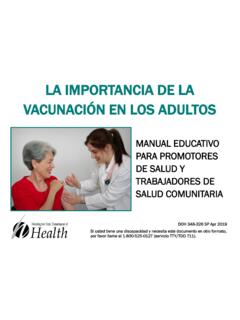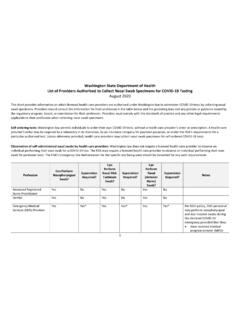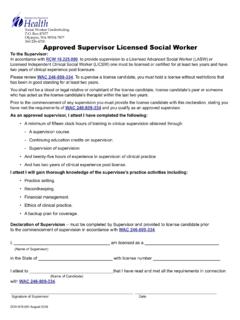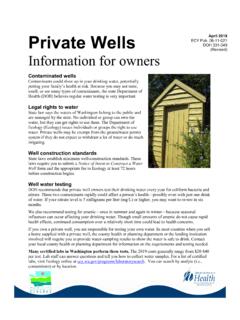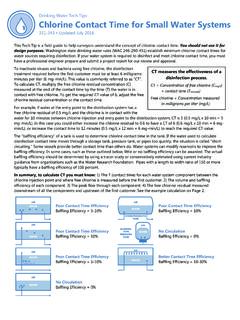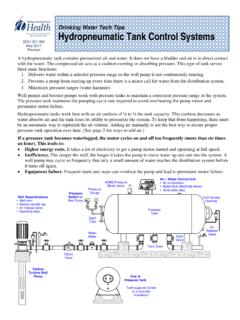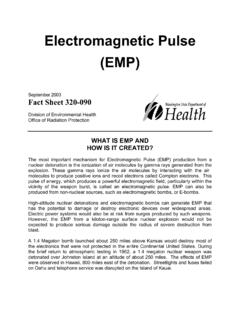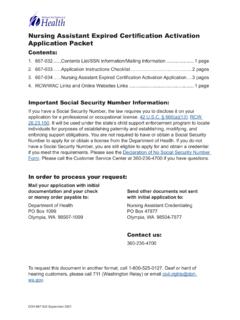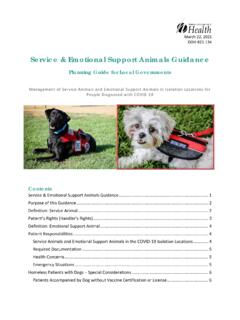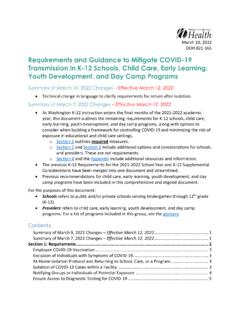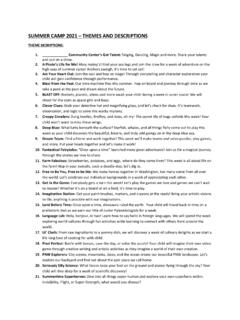Transcription of Requirements and Guidance to Mitigate COVID-19 ...
1 March 10, 2022 DOH 821-165 Requirements and Guidance to Mitigate COVID-19 Transmission in K-12 Schools, Child Care, Early Learning, Youth Development, and Day Camp Programs Summary of March 10, 2022 Changes Effective March 12, 2022 Technical change in language to clarify Requirements for return after isolation. Summary of March 7, 2022 Changes Effective March 12, 2022 As Washington K-12 instruction enters the final months of the 2021-2022 academic year, this document outlines the remaining Requirements for K-12 schools, child care, early learning, youth development, and day camp programs, along with options to consider when building a framework for controlling COVID-19 and minimizing the risk of exposure in educational and child care settings.
2 O Section 1 outlines required measures. o Section 2 and Section 3 include additional options and considerations for schools and providers. These are not Requirements . o Section 4 and the Appendix include additional resources and information. The previous K-12 Requirements for the 2021-2022 School Year and K-12 Supplemental Considerations have been merged into one document and streamlined. Previous recommendations for child care, early learning, youth development, and day camp programs have been included in this comprehensive and aligned document. For the purposes of this document: Schools refers to public and/or private schools serving kindergarten through 12th grade (K-12).
3 Providers refers to child care, early learning, youth development, and day camp programs. For a list of programs included in this group, see the glossary. Contents Summary of March 9, 2022 Changes Effective March 12, 2022 .. 1 Summary of March 7, 2022 Changes Effective March 12, 2022 .. 1 Section 1: Requirements .. 2 Employee COVID-19 Vaccination .. 3 Exclusion of Individuals with Symptoms of COVID-19 .. 3 At-Home Isolation Protocol and Returning to School, Care, or a Program .. 3 Isolation of COVID-19 Cases within a Facility .. 3 Notifying Groups or Individuals of Potential Exposure.
4 4 Ensure Access to Diagnostic Testing for COVID-19 .. 5 2 Reporting COVID-19 Cases and Outbreaks and Working with Public Health .. 5 Responding to Clusters and Outbreaks .. 5 Section 2: Information on Optional Strategies for Layered Prevention .. 5 Vaccination .. 7 Masks .. 7 Screening Testing .. 8 Test to Stay .. 8 9 Physical Distancing .. 9 Bus Transportation .. 10 Handwashing and Respiratory Etiquette .. 10 Cleaning and Disinfection .. 10 Section 3: Supplemental Considerations .. 11 Behavioral & Mental Health .. 11 Equity .. 12 Individuals at High Risk and Those with Disabilities.
5 12 Infant and Toddler Care .. 12 Returning to School or a Program after Travel .. 12 Screening Testing for Events and/or After Breaks .. 12 Performing Arts .. 12 Athletics .. 13 Screening Testing for Sports, Performance Arts, or Other Activities/Events .. 13 Other Co-curricular or Extracurricular Activities (CTSOs, Clubs, Interest Groups, STEM Fairs, Field Trips, etc.) .. 14 Section 4: COVID-19 Information and Resources .. 14 Additional COVID-19 Resources for Schools and Providers .. 14 General COVID-19 Resources .. 14 Appendix A: Glossary of Terms .. 15 Section 1: Requirements Schools and providers are required to continue to adhere to the Requirements in this section when applicable.
6 Employee COVID-19 Vaccination Exclusion of People with Symptoms of COVID-19 At-Home Isolation Protocol and Returning to School, Care, or a Program Isolation of COVID-19 Cases within a Facility Notifying Groups or Individuals of Potential Exposure Ensure Access to Diagnostic Testing for COVID-19 Reporting COVID-19 Cases and Outbreaks and Working with Public Health Responding to Clusters and Outbreaks Schools, districts, providers, programs, and/or LHJs may choose to put more protective policies in place, which are also required to be followed. 3 Employee COVID-19 Vaccination All employees in educational settings are required to be fully vaccinated or have a medical or religious exemption per Governor s proclamation Exclusion of Individuals with Symptoms of COVID-19 Students, children, and staff who have symptoms of COVID-19 , are required to stay home and should get tested and/or see a health care provider and follow the return to work/care/school protocol accordingly (see At-Home Isolation Protocol and Returning to School or a Program section).
7 See also the What to do if a Person is Symptomatic flowchart as a reference. Any student, child, or staff member who tests positive for COVID-19 is required to isolate at home following current guidelines from DOH (see At-Home Isolation Protocol and Returning to School or a Program section) and the CDC. This isolation Guidance applies regardless of vaccination status. At-Home Isolation Protocol and Returning to School, Care, or a Program A student, child, or staff who tests positive for COVID-19 is required to isolate at home, regardless of vaccination status. The isolation period is 10 full days from the start of symptoms or the date of positive test.
8 See Calculating Your Isolation Period for additional information. The individual may return to school/care after 5 full days of isolation if: Their symptoms have improved or they are asymptomatic, AND They are without a fever for the past 24 hours without use of fever-reducing medications. AND IF returning to school/care days 6-10, the individual is required to: Wear a well-fitted mask or face shield with a drape during days 6-10 of their isolation period, consistent with CDC Guidance , OR Test negative with an antigen or at-home test any day after day 5 before returning without a mask.
9 Testing beyond day 10 is not necessary. If the individual is not able to wear a well-fitted mask or face shield with a drape, AND does not test negative, they are required to continue isolating through the end of their isolation period. See also the What to do if a Person is Symptomatic flowchart as a reference. Isolation of COVID-19 Cases within a Facility Any student, child, or staff who reports or exhibits COVID-19 -like symptoms is required to be immediately isolated from others, sent home, and referred to diagnostic testing as soon as feasible, regardless of vaccination status.
10 While waiting to leave the school or program, the individual with symptoms is required to be isolated in a designated isolation space. They are required to wear a well-fitting face mask, if tolerated and age appropriate. Anyone providing care or evaluation to the isolated individual is required to wear appropriate PPE. Mask are required by all children, staff, and visitors aged 2 years and older in the nurse/health room and in the isolation room as these are considered health care settings. Staff may require a certain level of respiratory protection when working with individuals in isolation who are known or suspected to have COVID-19 .
